Get yourself in some better waves with this guide! Everything you need to know to read a surf report and find suitable waves for your next session.
Part of the thrill of being a surfer is figuring out how to read the ocean. One day the waves at your local break could be knee high and messy and the next it could be overhead and perfect. In some instances, you may even find that the waves are a foot bigger at a spot 30 minutes away from your home-break. For this reason we (surfer's) are obsessed with tracking the weather, hoping to see that red blob show up on the swell charts within our swell window.
Living in the northeast, timing is everything. When you see the swell start to line up and the buoy jumps, you need to time it right to get the best conditions before the swell starts to fade or the winds switch onshore.
To get the timing right you need the ability to analyze the surf report and surf forecast to find the best time and place to go surf. It's for that very reason we put together this guide, to teach the average surfer a bit of surf science so they can put themselves in good waves and continue to progress in their surfing.
THE FIRST STEP...
Is knowing the waves that you are comfortable surfing in.
If the surf report is telling you that the waves are head high and have some power behind them, it may not be a great idea to go surfing if you're new to the sport, or not comfortable in big conditions. Chances are you would have a tough time in these conditions and should wait for the waves to drop in size and become a bit more manageable.
You may not see too many experienced surfers out there when the waves are small, and you definitely will not see pro surfing videos with knee high waves. But guess what? Most of these athletes started their surfing career in small, weak surf.
WHERE DO WAVES COME FROM?
To break down a surf report we must first start with the basics. Where waves originate from can tell us a lot about the surf conditions when they hit the coast.
The waves that you surf travel a long way before arriving at your local break - in fact, the origin of waves is that big glowing ball up in the sky (and we’re not talking about the moon). The sun is the driving force for all weather on the Earth - and therefore the waves that we surf.
We will go into more detail on this entire process on a separate post coming soon, but to make a long story short, waves are formed by the movement of wind over the ocean which creates “chop” (think whitecaps on the ocean during a windy day). This wind chop is technically energy that was transferred from the wind into the water. At first the chop is a little chaotic, especially during the storm, but begins to organize into swell as it propagates (or moves away from) the storm center and towards the coast.
The size of the swell is dependent on the wind within the storm, in particular the wind speed and duration, and the total wind area (“Fetch”). The stronger the wind, over a long fetch area, the bigger and more powerful the swell. Keep in mind that most of these large swell producing storms happen way out in the middle of the oceans, so the swells have to travel a long way to reach the shore.
KEY TERMS
There are plenty of websites that provide surf reports for breaks throughout the world, however these sites do not always tell the full story. They may be based thousands of miles from your spot and lack knowledge of the area (with the exception of our LOCAL surf report updated daily HERE ). Because of that, local knowledge will ultimately help you score the best waves during a run of swell - knowing which conditions make certain breaks come to life.
Surf Reports determine wave size based on swell direction, wave height and period, and local winds. To help you make the most out of reading a surf report, it can help to have a good understanding of the following key factors:
- Swell Height
- Swell Period
- Swell Direction
- Wave Height
- Wind Speed + Direction
Let's go through each of these key factors to get an idea for how they affect the surf at your beach.
*Note: We go over many more terms related to waves and surf science in our Total Surf Glossary
But before we get into the terms... it's important to know the difference between swell and waves. It's quite simple actually.
Think of "swell" as waves propagating in the open ocean - moving in a specific direction but never actually breaking. When we talk about "waves", think about waves or the surf as it approaches the coast. This is when the swell begins to "feel" the bottom and begin to break. We'll talk more about this later.
SWELL HEIGHT
The swell height is the measurement from the “trough” of an unbroken wave to the “crest”. A good place to find this data would be to take a look at your local buoy . This will typically tell you the swell height (measured in feet) and swell period (measured in seconds) (i.e. 3ft @ 10s). These two factors tell you what the swell looks like and gives you a good idea of what the wave height (breaking wave) should be.
SWELL PERIOD
A swell period is the frequency, or time between two separate waves, crest to crest. Swell period measured in seconds (see diagram above in swell height).
Swell period is a direct measurement on the energy stored in a particular swell. A shorter period (6-12 seconds), known as a windswell, will be relatively weak and will most likely form smaller waves when the swell hits the coast. Longer period swells (12 - 20s), or groundswell, are much more powerful and are formed from a powerful storm with strong winds over a large fetch area. Ground swells create the best surf for most areas, and if you see a long period swell pointed at your beach, be ready to drop everything and go surf!
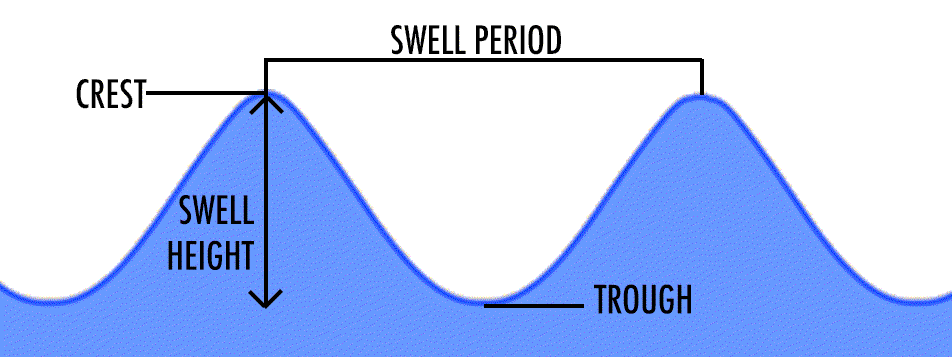
SWELL DIRECTION
Swell direction is the direction that the waves are approaching from. For example, when a surf report says the swell is out of the SE, this refers to the direction that the swell is originating from. For this reason it is useful to have an idea for your home breaks “ Swell Window ”, the range of swell directions that provide a swell unobstructed, straight-line access to your home break. Here in Rhode Island, we typically get swells ranging from southwest through straight east (highlighted in green on compass to the right).
Often times you will see well direction written in degrees. Refer to the compass on the right to get familiar with how these degrees stack up. For example, a swell direction of 130 degrees is a SE swell.

WAVE/SURF HEIGHT
Similar to the swell height, the wave height is the measurement of a wave from the trough to the crest (bottom to lip) on a wave that is about to break. The key word there is that the wave is about to break - whereas swell height is the height when the wave is still moving through deep water. There are many cases where you might find that the surf height is smaller than the swell height and vice versa. This has do with a funny little thing called "Shoaling", which is beyond the scope of this basic guide.
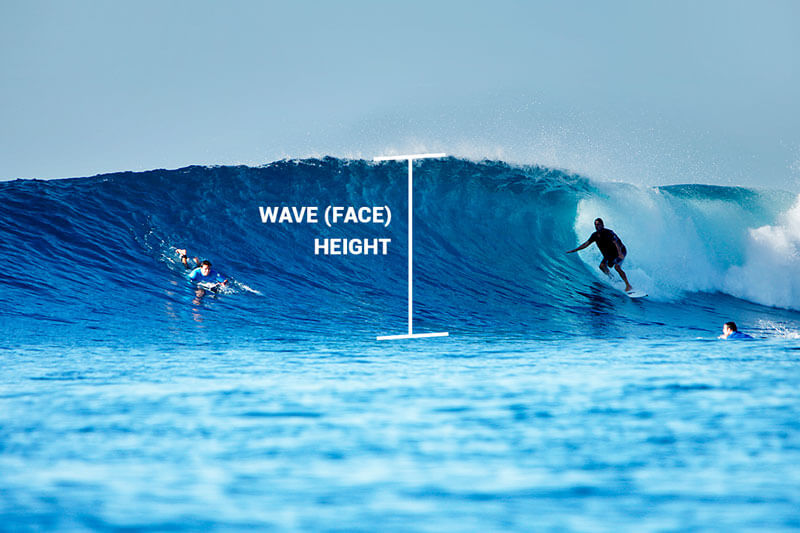
The funny thing is, the way people talk about wave height may be different depending on where you go. Some surfer's might say that the waves are 3 ft, while others will call it waist high. Surfer's in Hawaii have their own system entirely. They might call it 2-3 ft, and most other folks would call it 5-6 ft.
We prefer to call it waist high, stomach high, etc... it's less ambiguous that way.
Many factors come into play play, such as swell height, swell period, bathymetry, swell direction, and local wind direction. All of these factors will determine the size of the breaking waves at your home break.
WIND SPEED/DIRECTION
Since wind creates waves by transferring energy from the air to the water, you can guess that wind speed and direction plays a big role in the formation of surfable waves. Wind speed should be self explanatory, the velocity at which the wind is blowing. This paired with the direction of the wind plays a huge role in surf conditions, affecting the swell out at sea as well as conditions locally.
Wind Direction is the major player that you want to pay attention to when checking out a surf report. Onshore winds, as the name implies, blow from the ocean towards the shore, typically causing bumpy and unorganized conditions that are difficult to manage. On the other hand, Offshore winds blow from the shore out towards the ocean. This is the best type of wind to have (other than no wind at all!), causing clean and well groomed waves. Cross shore winds are a sort of a combination of both, but can be OK depending on the strength of the wind and the spot.
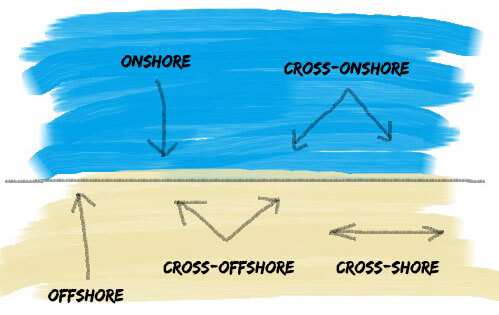
TIDES
A very important tool that you need to consider when looking at a surf report is the tide cycles - referring to the rise and the fall of the Earth’s oceans on a daily basis caused by the external pull/gravity of the sun and moon.
Basically, as the Earth spins, both the moon and the sun pull at the planet as it orbits around space. This "gravitational pull" causes the water to shift and flow depending on the movements of the moon and sun. This not only pulls the water towards the sun and moon, but also causes the water to bulge out in the opposite direction.
On the east coast of the US, every 24 hours (one full rotation of the Earth) produces 4 tides at our local breaks - 2 high and 2 low. We experience what is called a semi-diurnal pattern, meaning that the two highs and two lows of the day are about the same heights. This pattern varies in different places around the world, but we won't get into that in this basic guide. The image below depicts a basic semi-diurnal tide pattern.
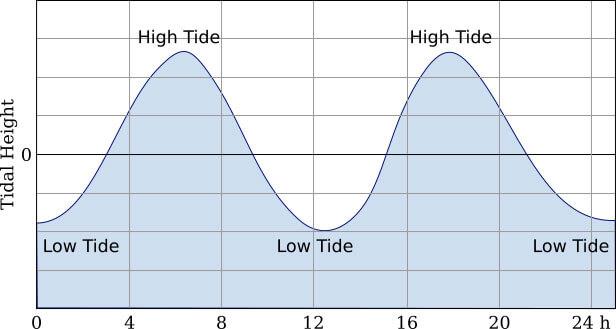
The tides have everything to do with how waves will break at a certain break. Some spots break better at a low tide, some better at a high tide, and some have a happy spot right in the middle.
The reason being each spot has its own unique bathymetry and features - and the tide controls the point at which the waves “feel” the bottom. There are spots that can go from head high at low tide to double over ankle at high tide! Most surf reports include tide data for the day, as well as an idea for which tides are best for the spot you are looking at. Although the best way to figure out the best tides for your favorite break is to go look at it multiple times a day.
BATHYMETRY
The bottom contours of the seafloor affects the depth of water (or bathymetry), which plays a major role in how the waves will break once they reach the shore, whether talking about locally or miles out to sea. As waves move from deep water into shallow water, they tend to turn and focus their energy to the shallower water. Ground swells, that pack more energy, “feel” the bottom sooner than windswell, and therefore are more influenced by bathymetry than windswell.
Understanding the main types of surf breaks and what causes them to break a certain way can eliminate some of the guesswork when choosing where to surf based on a surf report. Let's break down the major surf breaks characteristics.
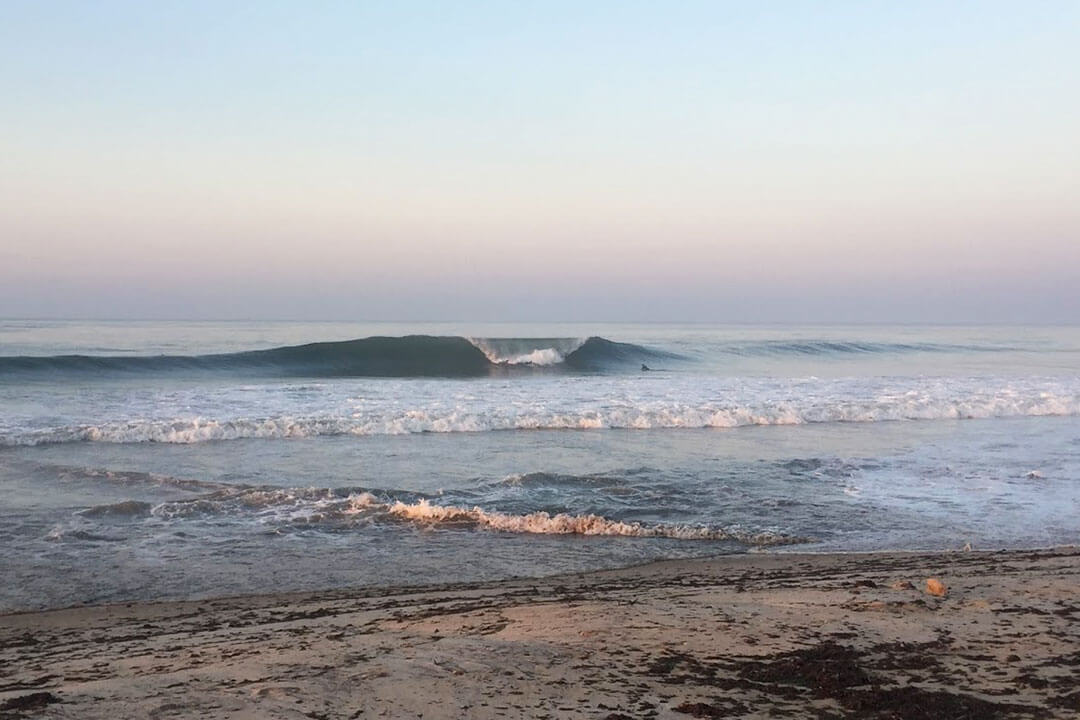
BEACH BREAK
A beach break is by far the most common place to surf around the globe and can be great for all skill sets. Beach breaks are places where the waves break over a sandy bottom, typically not far from shore - making them a great spot to learn to surf. Sand is always shifting on the bottom of the ocean in these environments due to storms and currents, causing wave quality to be somewhat variable and tough to predict. Sand banks/bars are always moving around, so some days there may be a perfect peak in one spot, and other days the best peak could have shifted down the beach 100 yards. Overall these are the best places to surf sloppy windswell. However, when a bigger long period groundswell is hitting the coast, beach breaks can sometimes close out along the beach - as the bathymetry is relatively the same everywhere.
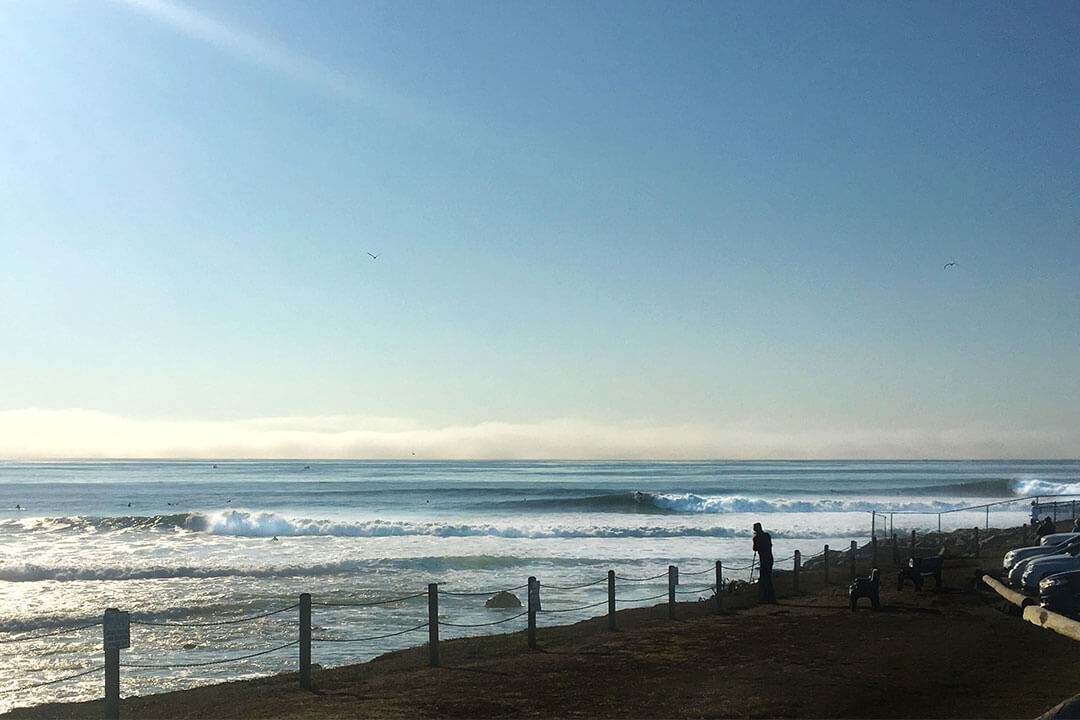
POINT BREAK
A point break is a type of waves that wraps around/along a point or headland (an area where the coastline comes to a point) creating long, predictable, and often times peeling waves. Point breaks typically have a rocky/coral bottom, but in some cases can have sandy bottoms. Many surfers consider point breaks to be the ideal wave - as it can offer a very long ride allowing the rider to link together multiple turns. Because of this, point breaks can often get crowded.. but a couple of long rides will make dealing with the crowd completely worthwhile. Make sure you bring a good leash and keep hold of your board when you wipeout to avoid losing your stick and having it swept up onto the rocks - this can lead to hefty surfboard repair costs and a tough swim in! Point breaks work on both windswell and groundswell, but work best with a proper groundswell. Jeffreys bay in South Africa is a classic example of a world-class point break. An example closer to home would be Point Judith in Narragansett (pictured left).
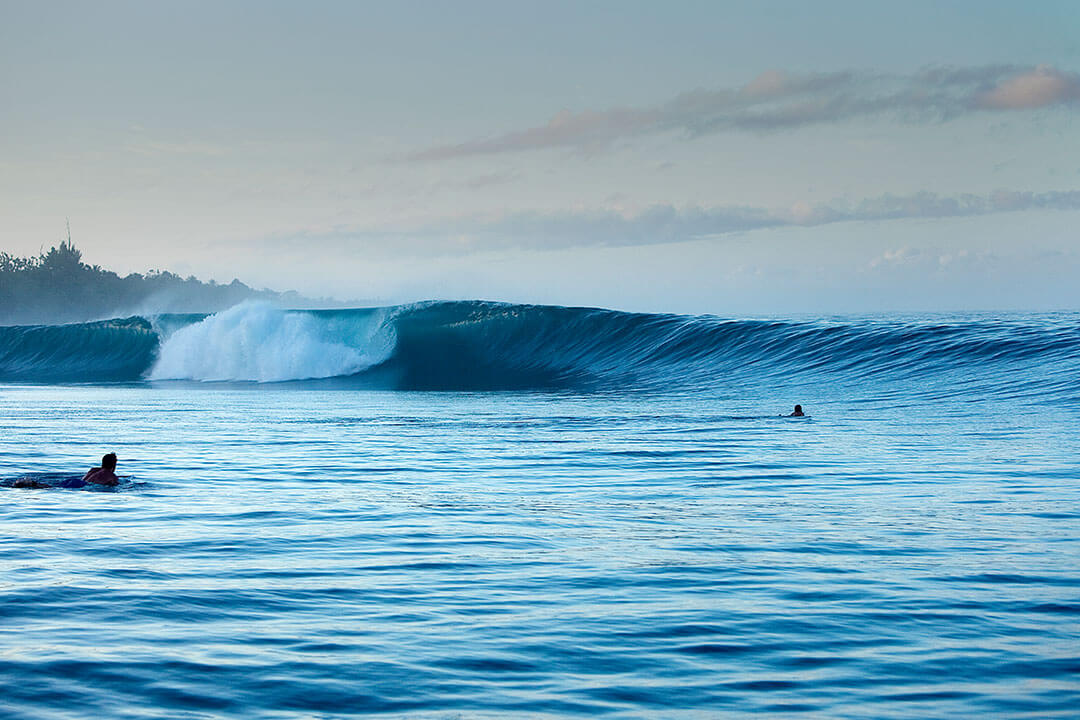
REEF BREAK
A reef break is a type of wave that breaks over a coral reef or rock bed - universally known as the most flawless type of waves in the world. Pair this with exposure to open ocean swell and your in for some fast, hollow barrels. Reef breaks are typically in an environment surrounded by deep water. When swells approach from deep water it will hit the shallow reef and jump in height before pitching out over the reef. Since reef breaks are known for breaking over razor sharp coral within only 2-3 feet of water - they are suited for more experienced surfers only.
GEOGRAPHY
The position of the surf spot in relation to the direction in which the swell is coming from is crucial to understanding the size of the waves that you can expect to see down at the beach. Many surf report websites out there do not take this into account for RI - so you need to keep this in mind. See the example below for two different swells with the same size approaching Point Judith, RI - one out of the southeast, and one from the southwest.
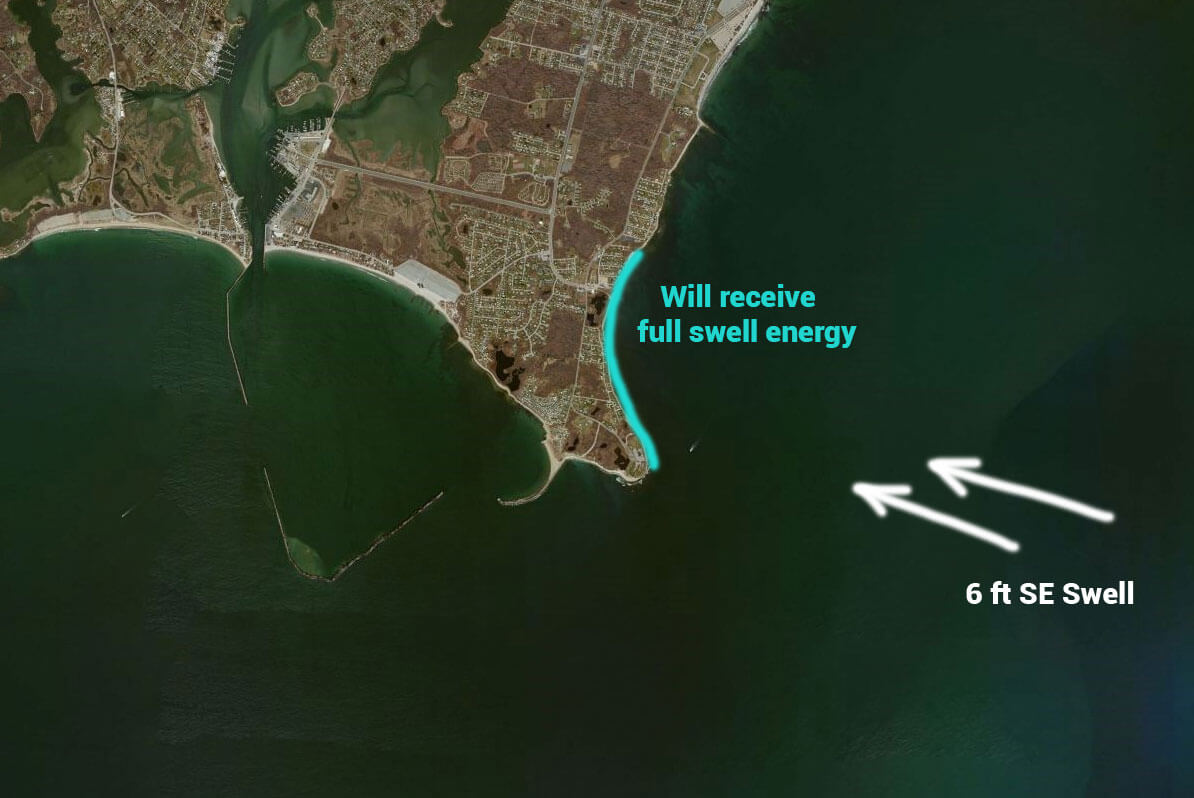
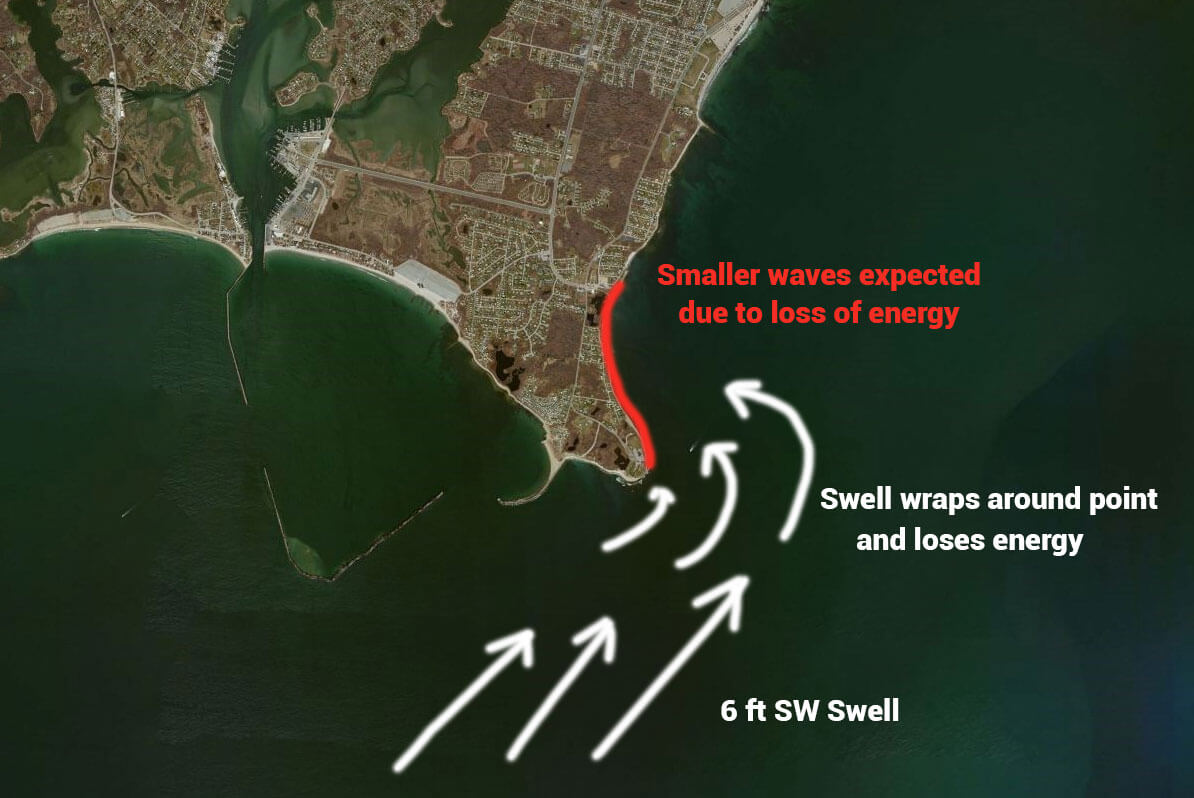
To keep it simple - let's say that a 6 foot swell aimed directly at an exposed surf break will result in 6 foot waves. For Point Judith this would mean a SE swell. There would be no loss of size in this case (hypothetically).
If the swell comes in at an angle that is not direct, the swell will lose energy based on the angle of difference. This is called Angular Spreading and is important for predicting the size of the swell that you can expect to see at your local break given a certain swell. As an example, a swell that comes in to your local break around 45 degrees off from direct will result in a loss of 10-15% loss of swell energy. If a swell comes in at 90 degrees off, you will see a 50-70% loss in swell energy.
In the scenario on the top right, a 6' SW swell at Point Judith would undergo close to 80-90 degree difference and therefore would result in a swell somewhere around 2-3 feet. For beginners this concept could help you find more manageable waves when the surf is big, which would be to seek out a beach or surf spot that does not directly face the swell.
This is where local knowledge wo uld come in to play! Know ing the geography of your local surf breaks will help you make the right decision when you see a swell pop up.
Keep in mind there are other factors that would come into play in these scenarios that would impact the wave height such as local winds, tides, swell period, etc.
SUMMARY
Now that you’ve read through this guide you should be able to interpret a surf report and make informed decisions on where you should surf given a set of conditions. Many surfers also keep a journal of their surfs, noting all of the information above, to help them determine the ideal conditions for the breaks that they surf most often. Remember: the best way to learn more about your local surf spots is to get in the water and surf!